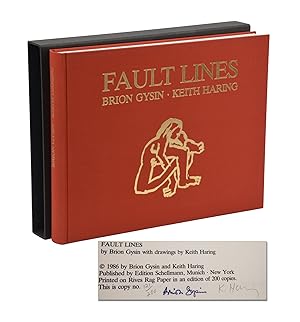Keith Haring Brion Gysin (4 results)
Product Type
- All Product Types
- Books (4)
- Magazines & Periodicals
- Comics
- Sheet Music
- Art, Prints & Posters
- Photographs
- Maps
-
Manuscripts &
Paper Collectibles
Condition
- All Conditions
- New
- Used
Binding
- All Bindings
- Hardcover (3)
- Softcover
Collectible Attributes
- First Edition
- Signed (2)
- Dust Jacket (2)
- Seller-Supplied Images (1)
- Not Printed On Demand
Free Shipping
Seller Location
Seller Rating
-
BRION GYSIN : Calligraphies, Permutations, Cut Ups. ------- [ Exposition du 16 Décembre au 17 Janvier 1987 ]
Published by Galerie de France
Seller: Okmhistoire, St Rémy-des-Monts, SARTH, France
First Edition
Couverture rigide. Condition: Comme neuf. Edition originale. Paris , 1987. 1 Volume/1. -- Comme Neuf -- Reliure éditeur cartonnée. Format in-4°. ------ 96 pages. **************** BILINGUE : Français // ENGLISH ----- Hardback quarto size. - as New - 96 pages - crisp color and black-and-white reproductions thruout. Basedon the January 1987 exhibition at Galerie De France.
-
The Last Museum
Published by Grove Press, New York, 1986
ISBN 10: 0394555554ISBN 13: 9780394555553
Seller: Village Works, New York, NY, U.S.A.
Book First Edition
Hardcover. Condition: Fine. Dust Jacket Condition: Near Fine. Haring, Keith (illustrator). 1st Edition. Foreword by William S. Burroughs. Cover art by Keith Haring.
-
Fault Lines
Published by Edition Schellmann, Munich and New York, 1986
Seller: Burnside Rare Books, ABAA, Portland, OR, U.S.A.
First Edition Signed
Condition: Near Fine. Limited Edition. Limited edition. Signed in pencil by Keith Haring and facsimile signature of Brion Gysin posthumously stamped on the limitation page. Numbered 121 of 200. Bound in publisher's red cloth stamped in gilt; house in black slipcase. Near Fine with light rubbing to case; light soiling to bottom textblock edge. A scarce collection of erotic stories with collotype illustrations by Keith Haring and texts by Brion Gysin.
-
Fault Lines [SIGNED BY GYSIN AND HARING. LIMITED EDITION]
Published by Edition Schellmann, München, New York, 1986
Seller: ERIC CHAIM KLINE, BOOKSELLER (ABAA ILAB), Santa Monica, CA, U.S.A.
First Edition Signed
Hardcover. Condition: Near fine to fine condition. First edition, Limited. 119/200. Large Oblong Octavo. Unpaginated. Original red cloth with gilt vignette and lettering stamped to cover, gilt lettering on spine; housed in plain black paper-covered slipcase. Printed to Rives paper, uncut at foredge. Numbered and signed in pencil by Keith Haring, and facsimile signature of Brion Gysin stamped to imprint page. Gysin had passed away shortly before the pages were prepared for signing. Illustrated with fifty-two full page erotic drawing by Keith Haring. Minor wear along binding, block crisp, with light streaking. Keith Haring (1958-1990), born Reading and raised in nearby Kutztown, Pennsylvania, was an American Pop-Art artist immersed in the graffiti subculture of New York in the 1980s. He had developed a love for drawing at a very early age, learning basic cartooning skills from his father and from the popular culture around him, such as Dr. Seuss and Walt Disney. In 1976 Haring enrolled in the Ivy School of Professional Art in Pittsburgh, a commercial arts school. He soon realized that he had little interest in becoming a commercial graphic artist and, after two semesters, dropped out. While in Pittsburgh, Haring continued to study and work on his own and in 1978 had a solo exhibition of his work at the Pittsburgh Arts and Crafts Center. Later that same year, Haring moved to New York City and enrolled in the School of Visual Arts (SVA). In New York, Haring found a thriving alternative art community that was developing outside the gallery and museum system, in the downtown streets, the subways and spaces in clubs and former dance halls. Here he became friends with fellow artists Kenny Scharf and Jean-Michel Basquiat, as well as the musicians, performance artists and graffiti writers that comprised the burgeoning art community. Haring was swept up in the energy and spirit of this scene and began to organize and participate in exhibitions and performances at Club 57 and other alternative venues.////// Haring was diagnosed with AIDS in 1988. In 1989, he established the Keith Haring Foundation, its mandate being to provide funding and imagery to AIDS organizations and children's programs, and to expand the audience for Haring's work through exhibitions, publications and the licensing of his images. Haring enlisted his imagery during the last years of his life to speak about his own illness and generate activism and awareness about AIDS./////// During a brief but intense career that spanned the 1980s, Haring's work was featured in over 100 solo and group exhibitions. In 1986 alone, he was the subject of more than 40 newspaper and magazine articles. He was highly sought after to participate in collaborative projects ,and worked with artists and performers as diverse as Madonna, Grace Jones, Bill T. Jones, William Burroughs, Timothy Leary, Jenny Holzer, Yoko Ono and Andy Warhol. By expressing universal concepts of birth, death, love, sex and war, using a primacy of line and directness of message, Haring was able to attract a wide audience and assure the accessibility and staying power of his imagery, which has become a universally recognized visual language of the 20th century.///// (Keith Haring Foundation) Brion Gysin was an American painter and writer of English birth. As a youth he spent time in Kansas City, MO, and Edmonton, Alberta, and briefly attended school in England before studying painting at the Sorbonne in Paris (1933-5). In 1934 his drawings were to have been exhibited at the Galerie aux Quatre Chemins in Paris alongside works by Dadaists and Surrealists, but they were removed by Paul Eluard on André Breton's orders. He later lived in New York City, Tangier, and Paris, where he spent the rest of his life. He collaborated with William S. Burroughs on books, and together they invented the 'cut-up' technique. His paintings involved a brushed calligraphic stroke, and he notably invented the 'Dreamachine' a device intended to create stroboscopic optical effects. (MOMA).




